You’ve all watched in the movies, what happens when the brake stops working. It’ll be a living nightmare if you don’t have the very best brake pads hooked to your cars. Brake pads come in different materials. Each having its own set of specialties to excel. That’s what we’ll be talking about here.
We’re all consumed by what makes the car go faster, which will boost up the acceleration. But you’ll have to keep it under a leash, otherwise, the consequences will be dire. Brake pads are what keeps cars on a leash.
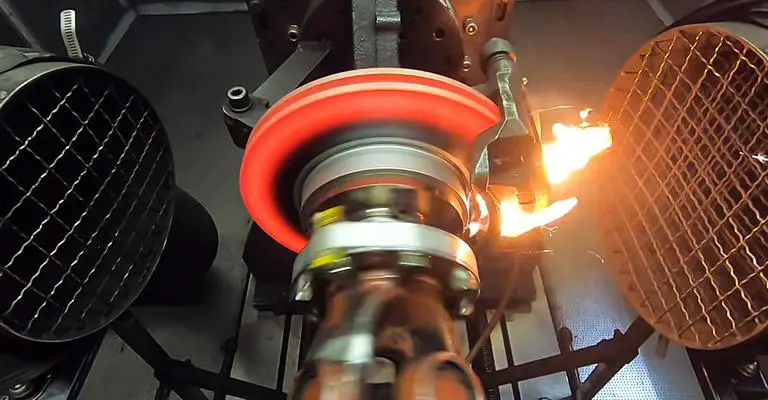
Contents
Types of Brakes Pads
Any auto mechanic may shout out “ceramic pads”, but a few know-how and why they fit in that position. Let’s take both constituents and your braking habits and analyze which fits your case.
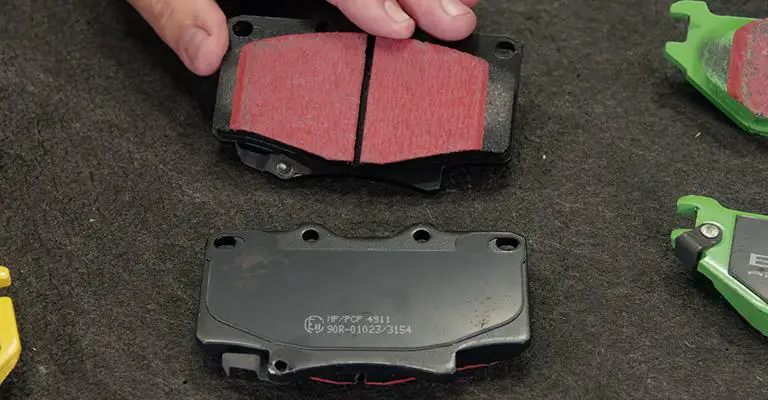
Asbestos Brake pads
In the early 80s, braking pads were made of Asbestos. It was a heat-absorbing material that worked well back then. But Asbestos brake pads used to squander away heat while applied.
Later, a highly-potent carcinogen was found in asbestos which causes cancer for continuous exposure. As the pads exposed asbestos to air, it was dangerous for all.
Organic Brake Pads.
Since then, the use of Asbestos in brake pads has gone up and organic matters have taken its place. Non-asbestos organic brake pads are a mixture of rubber, carbon particles, glass, Kevlar, fiberglass, etc. that are bonded together with extremely heat-resistant Resin.
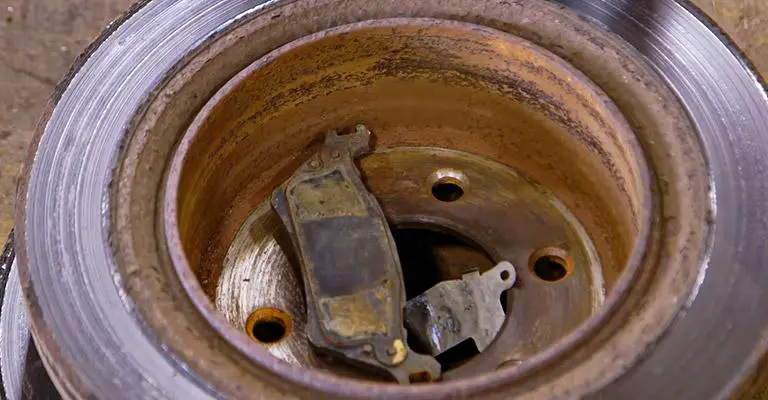
Semi-metallic Brake Pads
Nowadays semi-metallic pads are used in many vehicles on the road. It’s a kind of compound that contains 30% -70% metals like copper, iron, steel, or other composite shafts. These complex materials are combined with graphite mixers or other inorganic fillers to complete the pads.
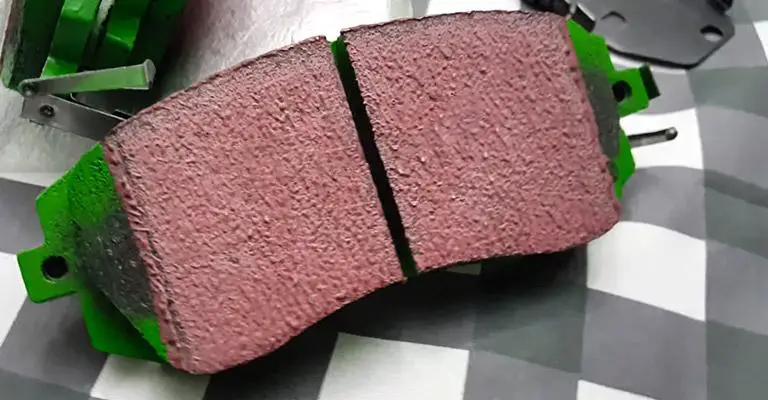
Carbon Fiber Brake Pads
These brake pads are the latest ones. Carbon fiber is a polymer of carbon or graphite. So, it’s known as graphite fiber too.
Surprisingly, it’s a very lightweight and strong material. Carbon fiber contains one-quarter of the density of steel, yet five times stronger than it. So it’s much more useful than other materials.
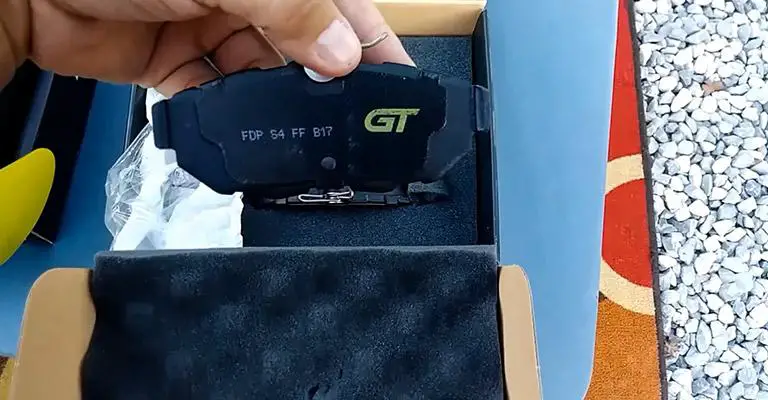
Ceramic Brake Pads
Ceramic brake pads are composed of similar yet more dense and durable clay and porcelain that are used to make plates and pottery.
These pads are made of nonferrous filled materials, stacked glass ceramic fibers, bonding agents, and a small account of metals like fine copper fibers inlaid in them, which helps to increase heat conductivity and friction.
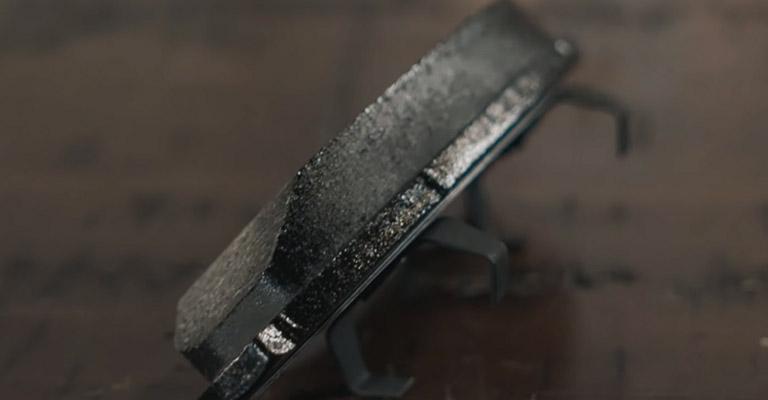
Brake Pads Comparison | Why Ceramic Brake Pads Are Ahead of Others?
The answer is quite simple. To explain the depth of the difference, below we highlight the main points of their pros and cons.
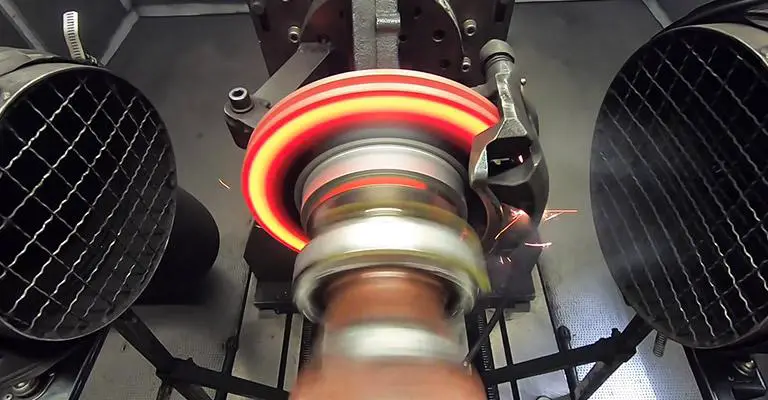
Organic v/s Ceramic Brake Pads
Here comes the multifarious battle of cost, features, and more…
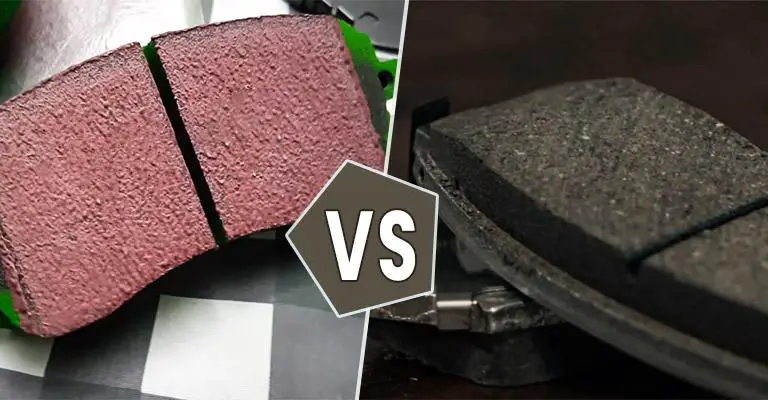
Price
Organic brake pads are made from natural substances. Therefore, they are cheaper in price. But don’t lean towards the cheap first. Because quality also matters. Ceramic brake pads are much more expensive. They require high manufacturing costs too. But the quality and other features of ceramic pads are really good.
Noise
Always choose a set of brake pads that makes your travel enjoyable with less noise. Surprisingly, both organic and ceramic brake pads are less noisy. Besides, ceramic brake pads create no extra sound while applied.
Dust
Organic pads create so much brake dust as they have a suitable amount of carbon particles. Well, ceramic brake pads are not completely dust-free. They do produce less dust, but relax! They do not stick to the car wheels or rotors.
Heat & Temperature
Organic pads work well in a certain range of temperatures. Being more abrasive, they overheat easily. Result in, they cannot work properly because of overheat or over-force. On the other hand, Ceramic brake pads are less corrosive. They do not overheat easily. So they can easily put up with different temperatures and conditions.
Performance
Not all brake pads are suitable for all types of vehicles. Ceramic pads are suitable for normal driving, but not for high-performance racing cars and heavy trucks. Organic pads are better for normal car use, yet not suitable for the racing or heavier ones.
Durability
Ceramic brake pads possess a higher lifespan than the organic ones. Experts assumed that a ceramic brake pad can last up to 70,000 miles. But organic pads are more prone to decay due to high friction. They wear down quickly and so you will need to change them frequently, which may cost plenty of money.
Semi-metallic v/s Ceramic Brake Pads
Though the criteria are the same, both being popular, the race’s neck and neck here!
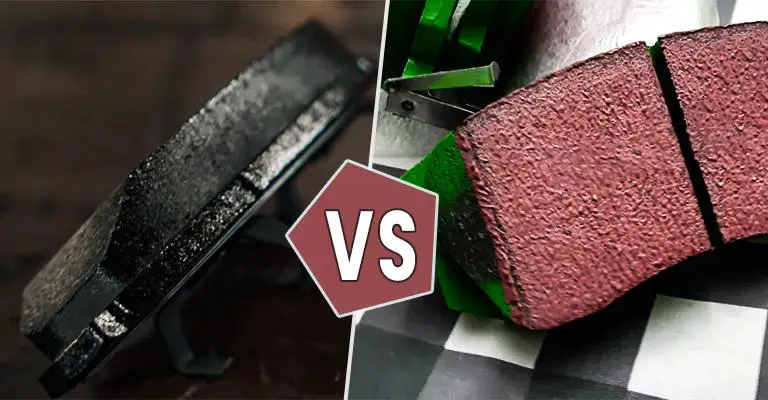
Price
If you are under a budget and want a better one, go for semi-metallic brake pads. Semi-metallic brake pads are expensive, but not as much as the ceramic ones. The price is almost between organic and ceramic pads.
Noise
Excessive noise can cause annoyance to the driver while driving. In that case, semi-metallic pads are much noisier than the ceramic brake pads because of having metal fibers and good stopping power.
Dust
Excessive smoke can stain your car’s wheels and rotors. Moreover, they pollute the environment. So look for low-dusting brake pads. Compared to ceramic pads, semi-metallic ones create more brake dust. Because semi-metallic brake pads contain graphite that creates black dust.
Heat & Temperature
Containing metallic particles, Semi-metallic brake pads can withstand and work well in a wider range of temperatures. But ceramic pads can become noisy during extremely chilling weather. Besides, semi-metallic pads are excellent conductors having excellent heat transfer.
Performance
Understand the type of your car and check the performance of the brake pads accordingly. Unlike ceramic pads, the semi-metallic pads offer excellent braking in high-performance racing cars and enormous trucks. So if you have a heavy van and want high performance, go for semi-metallic brake pads.
Durability
Generally, the ceramic pads wear out faster on the rotors than the semi-metallic pads. But, yet, ceramic brake pads are more long-lasting than semi-metallic pads. Adding more strain, semi-metallic pads fade away faster. So, they require frequent replacement.
Carbon Fiber v/s Ceramic Brake Pads
Comparison of high effectiveness
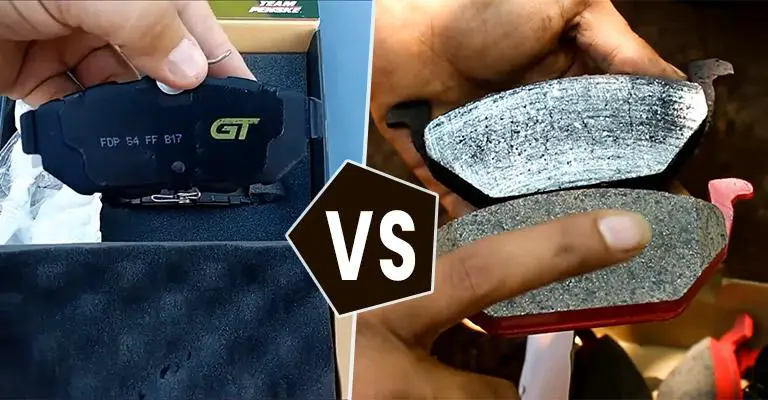
Price
Carbon fiber brakes are insanely expensive. But we admit that the better the thing, the higher the price. So their price is higher than the ceramic pads. Try to spend a little more money to buy the best. By doing so, you don’t have to worry about the extra costs in changing the pads repeatedly.
Noise
The less sound is generated the better. In terms of noise, ceramic and carbon fiber brake pads are almost identical. Mostly they are quieter. But both the pads do squawk a little when cold.
Weight
Everything is getting lighter and smaller with the use of technology. For the ease of use, carbon-fiber pads have been designed to be lightweight. As we mentioned earlier, they contain only one-quarter of the density of steel and no other weighty elements.
On the contrary, despite being made of heavy components, ceramic brake pads are surprisingly light and efficient.
Heat & Temperature
Carbon fiber brake pads have extreme high-temperature stability and thermal conductivity. Unlike ceramic pads, they can heat and cool down quickly. They can work effortlessly up to very high temperatures.
Performance
Actually, carbon fiber brake pads were developed for Aviation industries. Unlike ceramic pads, they are suitable for large aircraft and top-level sport racing cars like Pro Mods and Outlaw Radial cars. Although they are not suitable for use in ordinary vehicles. They work well in enormous trucks too.
Durability
If not sustainable, the prime purpose of making the carbon-fiber pads will be thwarted. They are less resistant to deformation or warping even at high temperatures. Therefore, they last longer than ceramic brake pads.
How to Break in Ceramic Pads
According to experts, it’s best to break in ceramic pads while buying a car or installing the pads. The procedure involved is known as the “bedding-in process”. Here’s how to go for it.
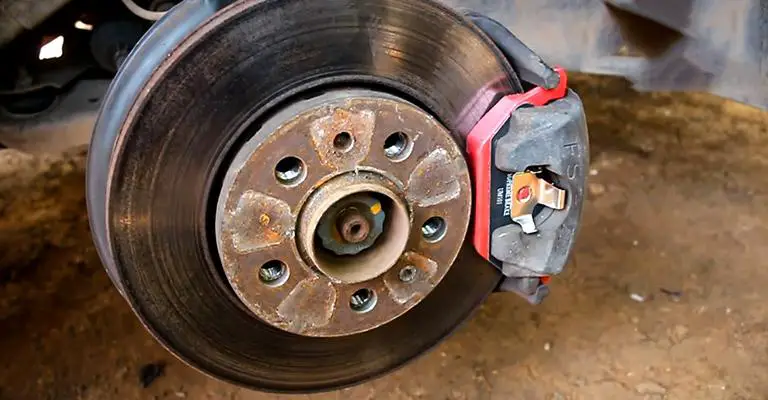
Step-1: Stop Less
Try not to stop for the first few hundred miles. This prevents the brake pads from overexerting.
Step-2: Brake Firmly
Speed up your car to 30-40 mph and firmly apply the brakes until the car slowly stops.
Step-3: Release the Heat
Allow 30 seconds to cool down. Repeat the first two steps for five times.
Step-4: Gear Up
Next, speed up your car to 45-55 mph once again, and brake to 20 mph.
Step-5: Cool Again
Now again let the pads go cool for about 30 seconds. Repeat the last two steps for five times.
FAQs
Q: How do brake pads work in a vehicle?
Ans.: The braking system turns the kinetic energy into friction. When you press on the brake pedal, it forces some hydraulic fluid to flow over the brake lines of each wheel. It pushes the pad against the rotor, which slows down the car and makes it stop.
Q: Can I Replace Ceramic Brake Pads Myself?
Ans.: If you have ever replaced brake pads before or are experienced enough with these, feel free to replace the brake pads in your own garage. But if you are not experienced or lack any automotive equipment, do not do it. So, we advise a trained mechanic to perform your replacement for the first time.
Q: Does it cost much to replace ceramic brake pads?
Ans.: In case you are not an expert and want a professional to replace the pads for you, then the cost may range from $100 to $300 per set. You may have to pay for other necessary equipment too. Apparently, the process can be said to be a bit costly. Again, if you want a complete brake job, it will cost you about $800-$1000.
Conclusion
The demand for brake pads varies from person to person depending on the type of vehicle and your budget. If you are on a budget or have a high-performance car, go for the semi-metallic brake pads.
The organic ones can be your lowest-price option too. But remember, the lower the price, the lower the performance and durability. Why bother with frequent brake pad changes and extra costs?
So even if the price is higher, considering noise, durability, performance wear and tear, washing, we will recommend ceramic pads.
Hopefully, you can choose the right brake pad for your car now. Good luck.
